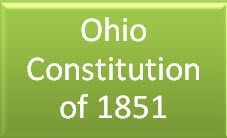THE
ROLE OF STATE GOVERNMENTS
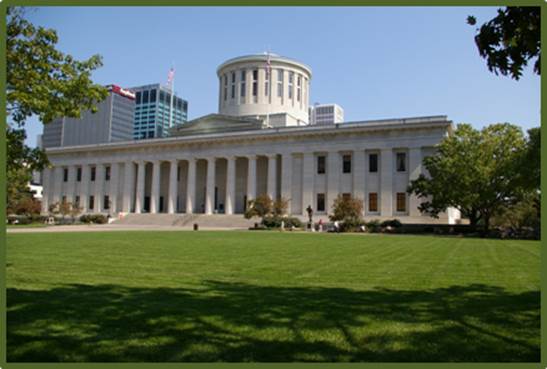
Ohio State House:
Photo Courtesy of the Ohio Attorney General's Office
Overview
Americans live under the jurisdiction of the federal
government, but they are also subject to the laws of their individual
states. Each state has developed a
constitution based on its unique history, geography, population and
resources. They act within the framework
of the U.S. Constitution and offer citizens additional ways of interacting with
the democratic process. State residents
balance their guaranteed rights with the responsibilities of citizenship. In this unit, we will use Ohio as an example
of how state governments operate and adapt to the changing needs of their
people.
State Governments in General
All state governments have several features in
common. Each one represents the supreme
law of the state just as the U.S. Constitution embodies the supreme law of the
nation. The layout of most state
constitutions is patterned after the U.S. Constitution; they customarily
include a preamble, several articles and a procedure for amendments. Like the federal Constitution, state
constitutions are considered living documents that can be changed in both formal
and informal ways. They incorporate the
basic principles associated with American government, such as popular
sovereignty and limited government.
Power is carefully divided among the executive, legislative and judicial
branches, as demonstrated by the example of Ohio in the graphic below.
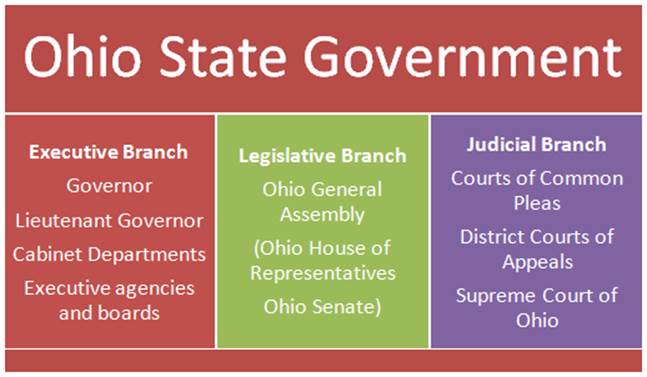
However, there are major differences between state
constitutions and the U.S. Constitution.
State instruments of government tend to be much longer and more detailed
than their national counterpart. For
example, the Ohio State Constitution contains nearly 37.000 words, which means
that it is over five times longer than the federal Constitution. It is also easier to amend than the U.S.
Constitution so the Ohio State Constitution has been changed more often. Rather than adding amendments in a numbered
list following the articles, Ohio makes note of them within the context of the
document. The same is true when an
amendment is repealed. This makes for
some very complex reading. Another
obvious difference is that the bill of rights is directly after the preamble
and is listed as Article 1. Many states,
including Ohio, have chosen to add a schedule
following the articles in their constitutions.
This section clarifies the time when the document goes into effect and
the method of ratification.
![MC900287144[1]](SSUSGU16_The_Governments_image007.png) Go to Questions 1-4.
Go to Questions 1-4.
Updating Early State Constitutions
The first state constitutions were comparatively
short and sometimes reflected a narrow perspective. As the United States has experienced social,
economic and political changes, many state governments rewrote their
constitutions a number of times, and Ohio was no exception.
Ohio Constitution of 1803
Ohio drafted its first constitution in November of
1802 as part of the process to become a state.
The constitutional convention called for this purpose was dominated by
the Democratic-Republican Party. Unlike
the Federalists, these politicians favored a scaled-down government with
limited powers. The responsibility for
governing primarily rested with the General Assembly, consisting of the Ohio
House of Representatives and the Ohio Senate.
Key judicial and executive officers were appointed by the legislature
and were not directly elected by the citizens.
Because Arthur St. Clair, the Governor of the Northwest Territory, did
not respect or work well with the legislature representing the Territory, the
constitutional convention believed it was necessary to restrict the power of
the new state’s executive branch. Ohio’s
first governors had no authority to veto acts of the legislature and were
limited to two-year terms. The judicial
branch consisted of the State Courts of Common Pleas and the Ohio State Supreme
Court, which was required to meet in every county of the state at least once a
year. In spite of its flaws, the Ohio
Constitution of 1803 was one of the most democratic state constitutions of its
time. All Caucasian men were given the
right to vote, as long as they paid taxes and helped to maintain the state’s
roads when asked. Following the
Northwest Ordinance, the Ohio Constitution of 1803 prohibited slavery but did
not go so far as to extend suffrage to African-American men. By 1850, however,
the need for a new state constitution had become apparent for a number of
reasons. Randolph C. Downes, author and
historian, identifies several of them in the following excerpt from his book, Ohio’s
Second Constitution.
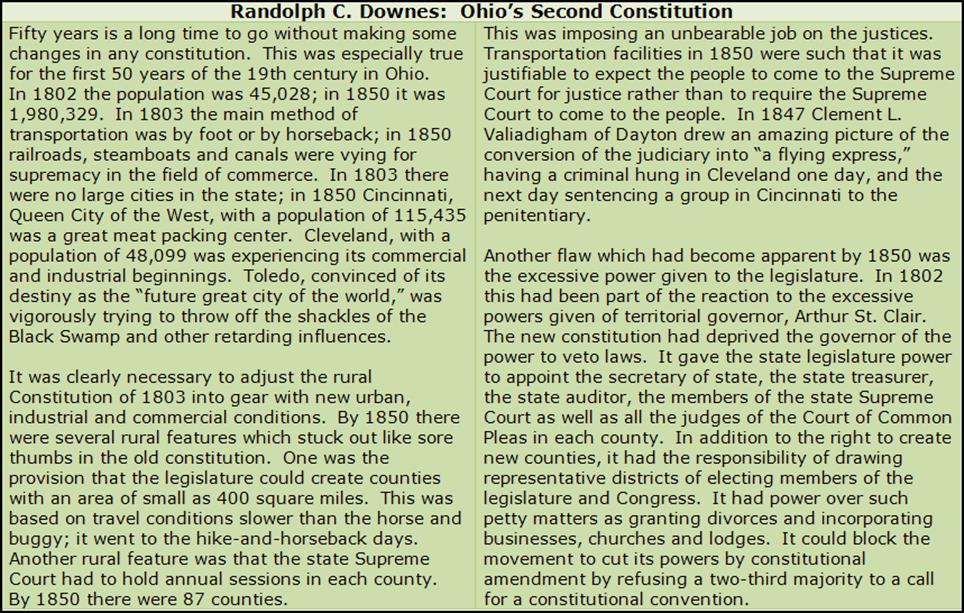
Ohio Constitution of 1851
The Constitution of 1851 made a number of
significant changes in Oho government.
It gave voters the right to elect high-ranking officials and judges rather
than have them appointed by the General Assembly. The new constitution banned retroactive
legislation, known as ex post facto laws, and demanded uniform regulations
throughout the state. Since two levels
within the state judicial branch were insufficient to process the increasing
number of cases, State District Courts of Appeals were added to the justice
system. The Ohio State Supreme Court was
no longer required to meet in the various counties around the state; this
increased its efficiency and saved valuable time. The new constitution banned poll taxes and
stipulated that citizens were to be taxed at a uniform rate. It also permitted the General Assembly to
borrow money when necessary and stated a specific limit on the amount of debt
it was able to acquire.
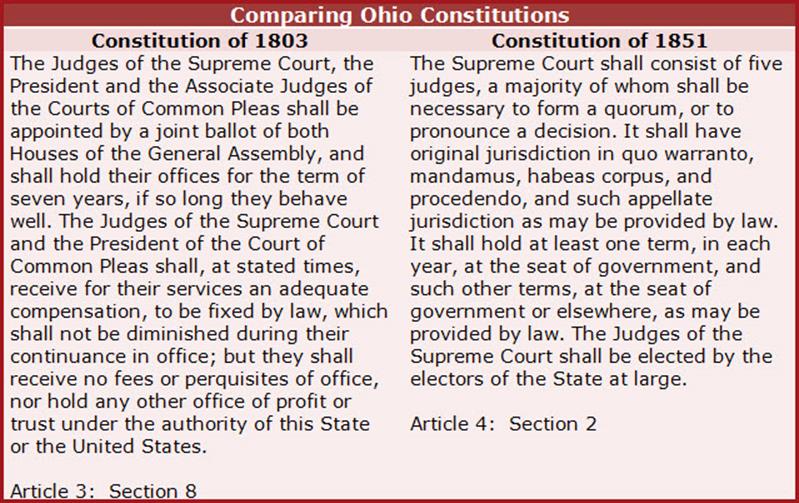
Although this document solved a number of problems,
the Ohio Constitution of 1851 remains a work in progress. It requires that voters be asked every twenty
years whether a constitutional convention is needed. Although the Ohio constitution has not been
updated in its entirety since 1851, conventions were held in 1873 and
1912. At these meetings, delegates
proposed the addition of several amendments and the repeal of some
provisions. You can view the full text
of the documents discussed in this section by clicking on the buttons below.
![MC900287144[1]](SSUSGU16_The_Governments_image007.png) Go to Questions 5 through 12.
Go to Questions 5 through 12.
Initiative, Referendum and Recall
As the Progressive Movement spread across the United
States in the early 1900s, several states, especially in the Midwest and the
West, looked for ways to increase the direct participation of citizens in the
lawmaking process on the state level.
This brought about the adoption of procedures known as initiative,
referendum and recall.
Ř Referendum: The goal of a referendum is to give voters
the opportunity to approve or to reject legislation that has been already
passed by a state legislature. In Ohio,
the process begins with a petition signed by at least 6% of the state’s registered
voters with a minimum of 3% from forty-four different counties. This must be accomplished within ninety days
of the Governor signing the law and registering it with the Secretary of
State. Certain laws, however, are exempt
from referendum. These include emergency
laws, levies and appropriations for current expenses.
Ř Initiative: The initiative process
also begins with a petition and a specified number of signatures. The goal is to propose a new law or state
constitutional amendment that the legislature has not already passed. Ohioans can begin this procedure by writing a
draft of the proposal and collecting 1,000 signatures. These are submitted to the Ohio Secretary of
State and the Attorney General for verification. Then, signatures are collected again from at
least 10% of the number of voters in the last gubernatorial election with
representation from forty-four of Ohio’s eighty-eight counties. These signatures must be presented to the
Ohio Secretary of State at least 125 days prior to the next general
election. Once everything is in order,
the Ohio Ballot Board then prepares to place the proposal on the ballot.

Wisconsin's Attempt to Recall Governor Walker
Ř Recall: In fifteen states, not including Ohio, voters
can remove the governor or state legislators from office through the process of
recall. This procedure also begins with
a petition. If successful, a special
election is held to remove the individual from office with a majority
vote. In a recent case, Michigan voters
forced two state senators out of office for voting for tax increases.
![MC900287144[1]](SSUSGU16_The_Governments_image007.png) Go to Questions 13 through 15.
Go to Questions 13 through 15.
State Agencies
Ohio, along with the other states, provides
services, protection and information that give citizens the opportunity to lead
healthy and productive lives. This duty
is carried out by over 150 state agencies, departments, boards and
commissions. Each one offers a means for
Ohioans to interact with state government and to influence public policy. Some agencies, such as the Ohio Environmental
Protection Agency and Ohio Homeland Security, work directly with their counterparts
on the federal level. Others are
involved with issues more specific to Ohio.
The chart below lists several examples of state agencies and their
functions.
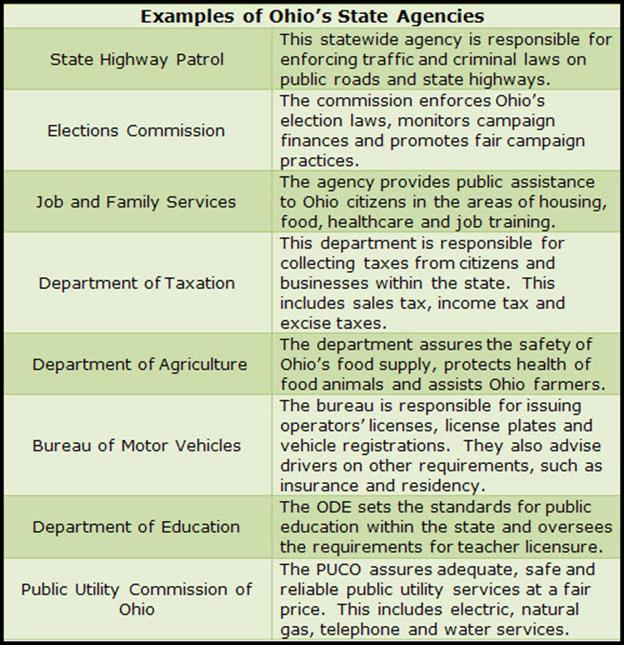
State governments, however, must be able to pay for
the services that they offer. Just like
the federal government, states rely on taxes for a large portion of their
revenue. In most states, sales taxes are
the greatest single source of funds.
Other forms include taxes on property, specific products, income and
corporations. All states generate
operating money by issuing licenses, charging fees and collecting fines. State-regulated gambling and lotteries are
also used to supply additional funding.
Even with all of these financial resources at their disposal, states
often borrow money to finance large projects and to meet emergencies. The pie charts below represent revenue and
expenditures as estimated by the Office of Budget and Management for the state
of Ohio in 2014-2015.
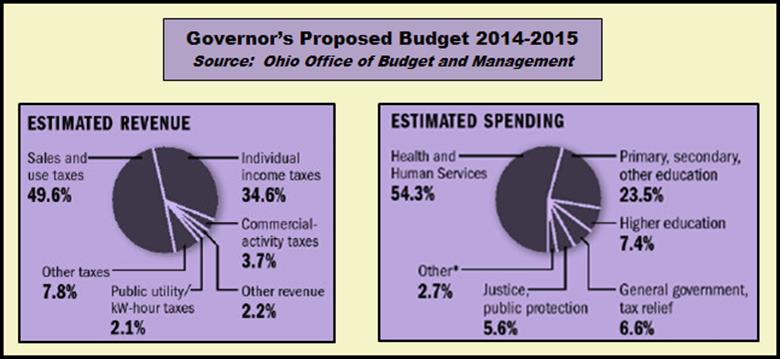
![MC900287144[1]](SSUSGU16_The_Governments_image007.png) Go to Questions 16 through 18.
Go to Questions 16 through 18.
Rights v Responsibilities
On all
levels of government, Americans are proud of their right to participate in the
democratic process, to exercise their basic freedoms and to make choices that
improve their standard of living. These
privileges are balanced, however, with the responsibilities of citizenship. U.S. citizens can select their own government
officials by engaging in their right to vote, but their ballots are only
effective if they are well-informed about the candidates and the issues. Individual liberties, such as freedom of
speech and freedom of the press, are limited by other people’s rights. For trial by jury to exist, citizens must be
willing to testify in court and to serve on juries. An Ohioan’s right to a public education
requires a respect for established school procedures and policies. Good citizenship is also expressed through a
willingness to serve. This includes
joining the military, running for public office and supporting community
improvement projects.
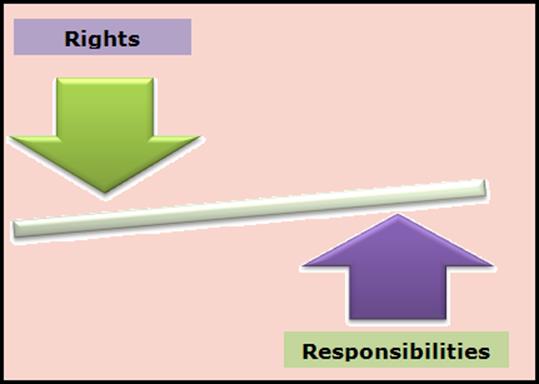
![MC900287144[1]](SSUSGU16_The_Governments_image007.png) Go to Questions 19 and 20.
Go to Questions 19 and 20.
What’s Next?
In this unit, you read about state governments and
their connection to the federal system.
State constitutions reflect the U.S. Constitution but contain provisions
unique to their own individual circumstances.
Citizens work within their states to solve problems and to create public
policy, but they can also improve their communities by working through local
channels. In the next unit, you will
read about a specific issue and one town’s attempt to resolve it. Before moving on, review the terms in Unit
16, and complete Questions 21 through 30.
![MC900287144[1]](SSUSGU16_The_Governments_image007.png) Go to Questions 21 through 30.
Go to Questions 21 through 30.

Below are additional educational resources and activities for this unit.

